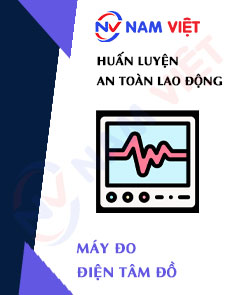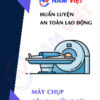Occupational Safety Training for Operating Electrocardiogram (ECG) Machines
99,000 ₫
Note: The above price is calculated per person and may vary depending on the number of trainees participating in the course and market fluctuations. For more accurate pricing support, please refer to the pricing list or contact our consulting staff directly.
Occupational safety is an important issue when operating the Electrocardiogram (ECG) machine and needs to be addressed promptly to ensure the health and safety of workers and enhance the reputation of businesses here. The Occupational Safety Training is one of the effective solutions to raise awareness on how to prevent occupational accidents for workers operating the Electrocardiogram (ECG) machine.
Table of Contents
Toggle1. Overview of the Electrocardiogram (ECG) Machine
a. What is an Electrocardiogram (ECG) Machine?
The Electrocardiogram (ECG) machine is a widely used medical device that records the electrical activity of the heart. It captures electrical changes in the heart through sensors attached to the patient’s skin, typically on the chest, arms, and legs. These changes reflect the activity of heart muscle cells during contraction and relaxation.
Recording an ECG allows doctors to assess the integrity of the heart’s electrical system, detect heart rhythm problems, and evaluate abnormalities in cardiac electrical activity. The ECG machine produces a chart called an “electrocardiogram,” displaying different electrical waves over time, providing detailed information on the shape and interval of the heart’s electrical signals.
By analyzing an electrocardiogram, doctors can diagnose and monitor many cardiovascular conditions, including but not limited to angina, arrhythmias, heart failure, endocarditis, and complications from other diseases such as diabetes.
The ECG machine has become an essential tool not only for diagnosing heart diseases but also for monitoring patients’ cardiovascular health during treatment and recovery.

b. How the Electrocardiogram (ECG) Machine Works
The operating principle of the ECG machine is based on recording and analyzing the heart’s electrical activity. Here’s how it works:
- Electrodes: ECG machines use sensors attached to the patient’s skin to capture electrical signals from the heart. These electrodes are usually placed in multiple locations such as the chest, arms, and legs.
- Signal Recording: As the heart works, heart muscle cells generate small electrical currents. The sensors on the skin record these electrical changes and transmit them to the ECG machine.
- Amplification: The electrical signals from the sensors are very small, so they are amplified to create larger, measurable signals.
- Filtering: Signals are filtered to remove noise and retain only accurate cardiac signals.
- ECG Graph: The electrical signals are plotted on a time-based chart, showing ECG waves, including the P wave, PQ interval, QRS complex, and ST segment.
- Analysis: Doctors or medical staff analyze the ECG chart to assess heart function and identify any abnormalities, such as heart rate, rhythm, and variations in the shape and size of waves.

c. Industries Using Electrocardiogram (ECG) Machines
ECG machines are mainly used in healthcare and medical fields. Some key applications include:
- Clinical Medicine: In clinical settings, ECG machines are widely used to diagnose and monitor cardiovascular conditions. Clinicians use ECGs to assess patients’ heart health, detect arrhythmias, valvular heart disease, angina, and other heart-related issues.
- Hospitals and Clinics: ECG machines are used for diagnosis, monitoring, and treatment of cardiovascular diseases. Doctors, nurses, and technicians collect data on heart electrical activity to support treatment decisions.
- Cardiology Clinics: Specialized cardiology clinics use ECGs to evaluate and monitor patients’ heart health, particularly for diagnosing and managing arrhythmias, heart failure, and valve diseases.
- Emergency Medicine: In emergencies, ECG machines are used to assess and monitor patients’ hearts, enabling rapid identification of critical heart conditions and timely interventions.

2. Overview of Occupational Safety Training for Operating Electrocardiogram (ECG) Machines
a. What is Occupational Safety Training?
- Occupational safety training for operating ECG machines equips workers with knowledge on preventing workplace accidents. Workers who directly operate ECG machines belong to Group 3.
- Safety training helps workers recognize and prevent hazards, reducing risks of workplace accidents during operation.
REGISTER FOR OCCUPATIONAL SAFETY TRAINING
b. Training Duration
Initial Safety Training Duration:
- Total training time is at least 24 hours, including assessment time.
- 8 hours of theoretical study on policies and labor safety laws.
- 8 hours of theoretical study on basic occupational safety and hygiene knowledge.
- 4 hours of theoretical study on specialized training content.
- 2 hours of practical exercises on specialized training content.
- 2 hours for final theoretical assessment.
The training center may split the program into multiple sessions based on worker schedules, typically conducted over 6 sessions in 3 days, assuming the company can arrange continuous learning time.
Periodic Safety Training Duration:
- Before the occupational safety card expires, workers must undergo periodic safety training, with a duration of at least 50% of the initial training duration.
Explanation: Total duration for periodic safety training is at least 12 hours, including assessment. Upon completing the periodic training and passing the test, workers receive a renewed occupational safety card.
c. Training Content
| No. | TRAINING CONTENT | TRAINING TIME (HOURS) | |||
| Total | Including | ||||
| Theory | Practice | Assessment | |||
| I | Policies and laws on occupational safety and hygiene | 8 | 8 | 0 | 0 |
| 1 | Overview of legal documents and regulations on occupational safety and hygiene. | 6 | 6 | ||
| 2 | Standards and technical regulations on occupational safety and hygiene. | 1 | 1 | ||
| 3 | Specific regulations by government agencies on occupational safety during construction, expansion, renovation, and operation of production facilities, equipment, and hazardous substances. | 1 | 1 | ||
| II | Basic knowledge of occupational safety and hygiene | 8 | 8 | 0 | 0 |
| 1 | Basic knowledge of hazards in the workplace. | 4 | 4 | ||
| 2 | Methods to improve working conditions. | 1 | 1 | ||
| 3 | Safety culture in production and business. | 1 | 1 | ||
| 4 | Rights and obligations of employers and employees; safety policies; roles of safety officers. | 1 | 1 | ||
| 5 | Safety regulations, signage, personal protective equipment, first aid skills, and occupational disease prevention. | 1 | 1 | ||
| III | Specialized training content | 6 | 4 | 2 | 0 |
| Comprehensive knowledge of machines, equipment, hazardous substances; risk analysis and management; safe working procedures with machinery and substances. | 6 | 4 | 2 | ||
| IV | Final assessment of safety training | 2 | 2 | 0 | 0 |
| Total | 24 | 22 | 2 | ||
See more training content of the 6 groups
d. Occupational Safety Card
After completing safety training and passing the assessment, workers will be issued a Group 3 occupational safety card (commonly called Group 3 occupational safety certificate).
The card shows details such as name, date of birth, specific job and work environment, training duration, red seal, and signature confirming completion of the course.
According to the regulations in Clause 2 of Article 24 of Decree 44/2016/ND-CP, there are two cases:
- If the worker has a labor contract, the employer must sign, stamp, and seal the card after the worker completes the Group 3 training and passes the test.
- If the worker is freelance or temporary, the training organization must sign, stamp, and seal the card after the worker completes the training and passes the test.

3. Hazards for Workers Operating Electrocardiogram (ECG) Machines
Operating an electrocardiogram (ECG) machine generally does not pose major hazards to workers, but safety measures must still be followed to ensure safe and effective operation. Below are some hazards that may occur when operating an ECG machine and measures to mitigate them:
- Risk of electrical contact: Although ECGs use small electrical signals that are painless, workers need to be careful to avoid contact with wires or conductive parts of the machine while it is operating.
- Risk of overwork: Medical staff or technicians often work long hours and frequently with ECG machines. Continuous work can cause fatigue and stress, affecting work performance and health.
- Chemical risk: Some gel solutions may be used to help ECG sensors better contact the skin. However, improper use or prolonged contact with the gel may cause skin irritation or allergies.
- Ergonomic and posture risk: Workers should pay attention to their posture and frequently change positions to avoid muscle and joint strain.
- Information misinterpretation risk: Reading and interpreting ECG charts requires professional knowledge and skills. Misunderstandings or inaccuracies can lead to incorrect diagnoses and ineffective patient treatment.
To minimize these hazards, occupational safety measures should be implemented, including training workers on safe and effective use of ECG machines, providing appropriate personal protective equipment, ensuring comfortable and safe working conditions, and following hygiene and occupational safety practices.
4. Occupational Accident Control Measures When Operating ECG Machines
To control and reduce the risk of occupational accidents when operating ECG machines, there are several safety measures workers need to follow. Below are some occupational accident control measures for operating ECG machines:
- Training and guidance: Provide comprehensive training and guidance on safe and effective use of ECG machines to all medical staff or technicians working with these machines. Ensure they understand the hazards and necessary safety measures.
- Use of personal protective equipment: Provide PPE such as gloves, safety goggles, and lab coats to protect skin from direct contact with conductive gel and avoid electrical hazards.
- Periodic equipment checks: Perform regular inspections and maintenance of ECG machines to ensure proper operation and prevent malfunctions caused by technical errors.
- Maintain machine and workspace hygiene: Keep the workspace clean and organized, regularly clean the ECG machine and surfaces that contact conductive gel to prevent bacterial and mold growth.
- Follow safety procedures: Adhere to all safety procedures and manufacturer instructions when operating the ECG machine, including usage, storage, and handling.
- Ergonomic and posture management: Ensure workers maintain proper posture and frequently change working positions to prevent muscle and joint strain.
- Workload distribution: Distribute tasks reasonably among staff to avoid prolonged solitary work, reducing fatigue and accident risk.
- Periodic inspection of ECG machines to detect early safety issues such as wear, mechanical failure, or other malfunctions, thereby reducing occupational accident risks.

5. Benefits of Occupational Safety Training
An Toàn Nam Việt provides your business with the following benefits after completing occupational safety training courses in accordance with Decree 44/2016/ND-CP regarding occupational health and safety. Companies, factories, and enterprises can enjoy:
- Workers can identify potential occupational hazards and take preventive measures to avoid accidents.
- Your business can establish risk prevention measures in production, operation, and maintenance processes.
- Reduce costs associated with safety risks in the workplace.
- Uninterrupted production enhances labor productivity and product quality.
- Compliance with occupational safety laws reduces legal risks.
- Enhances reputation and professionalism, thereby elevating your company’s brand.
Nam Việt’s training courses are solutions to prevent external hazards affecting individuals, helping them avoid dangers that could cause injury or, in severe cases, death.
REGISTER FOR OCCUPATIONAL SAFETY TRAINING SERVICES
6. Customer Feedback After Completing Training
An Toàn Nam Việt has many years of experience supporting businesses across Vietnam, particularly in southern provinces. This responsibility is invaluable, so Nam Việt continuously professionalizes its Occupational Safety Training. Our growth has been driven by positive feedback and constructive suggestions from clients. Below are testimonials from partners we have served:
See more customer interviews after using the service at An Toàn Nam Việt
7. Occupational Safety Training Competence of An Toàn Nam Việt
An Toàn Nam Việt is a reputable and high-quality center for occupational safety training in Vietnam today. Safety training sessions are continuously conducted at manufacturing workshops, factories, or construction sites across the country (all 63 provinces in Vietnam).
REGISTER FOR OCCUPATIONAL SAFETY TRAINING SERVICE
License for occupational safety training
- An Toàn Nam Việt has been inspected and certified by the Department of Safety under the Ministry of Labor – Invalids and Social Affairs to meet the requirements for conducting occupational safety and hygiene training. This further strengthens our occupational safety training capabilities.

Training materials and lectures
- Before the occupational safety training materials are included in the OST courses, they are reviewed and verified to ensure accuracy and effectiveness when applied.
- Our instructors’ teaching methods are standardized according to the teaching standards of An Toàn Nam Việt, which have been researched and developed by experts in occupational safety and hygiene training to maximize knowledge absorption for trainees.
Facilities
- Controlling the factors in the classroom that affect the training process improves teaching efficiency and trainee knowledge retention.
- Our training facilities are always arranged with spacious classrooms that meet standards for area, lighting, and training equipment, etc.
8. Nationwide Reputable Safety Training Center
At An Toàn Nam Việt, we always prioritize the professional dedication to occupational safety training. For us, conveying knowledge for workers to protect themselves safely in their work journey contributes to national development.
To ensure effective training, we meticulously prepare every detail, no matter how small—from tools, teaching equipment, to curriculum, materials, sound, and lighting.
Our occupational safety instructors are experts with many years of experience. They even have research works on identifying hazards across industries and ways to prevent them.
Lectures are practical and presented in an engaging, easy-to-understand manner for workers. This creates a comfortable learning environment and ensures effective knowledge transfer. All teachings strictly follow Decree 44/2016/ND-CP.
This enables workers to understand preventive measures against hazards and how to protect themselves, applying the knowledge appropriately in real work situations.
Our Safety Training Center proudly provides professional, reputable occupational safety training services with the following advantages:
- Competitive training costs without compromising quality.
- Flexible training schedules that fit the production needs of companies.
- Quick and compliant procedures for issuing occupational safety training certificates.
- Experienced instructors with many years in the field.
- Classrooms are controlled to enhance teaching efficiency and trainee knowledge absorption.
- Lectures are tailored to occupational safety work in companies.
- An Toàn Nam Việt works dedicatedly and professionally to support customers accurately and promptly.

9. Additional Occupational Safety Training Materials
- Occupational Safety Training Materials Set
- Occupational Safety Materials for Operating Electrocardiogram (ECG) Machines
- Occupational Safety Training Test Set
- Occupational Safety Quiz for Operating Electrocardiogram (ECG) Machines
- Slides for Occupational Safety Training on Operating Electrocardiogram (ECG) Machines
1 review for Occupational Safety Training for Operating Electrocardiogram (ECG) Machines
No comments yet















phanminhhang341
Đơn vị chuyên nghiệp về huấn luyện an toàn lao động